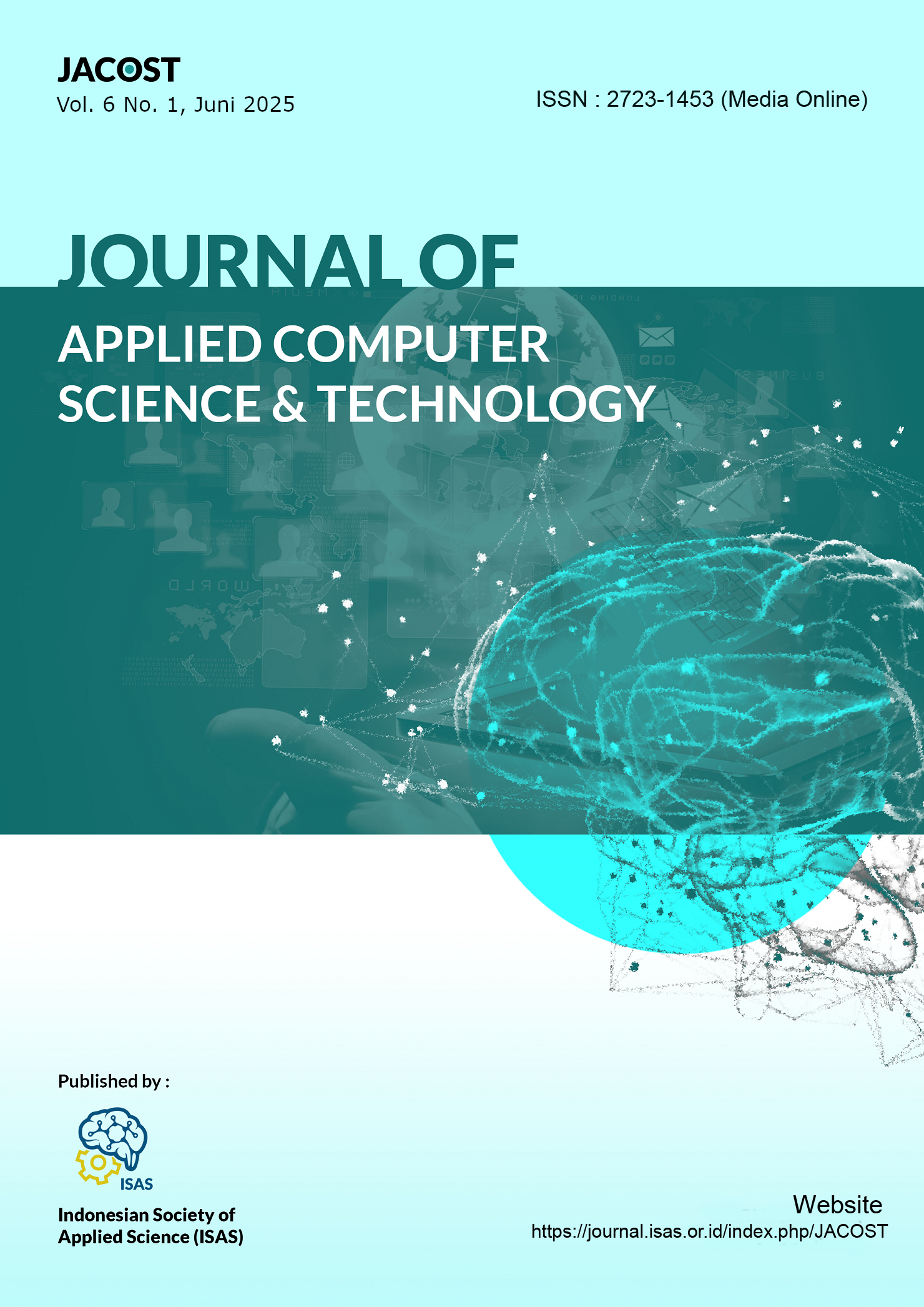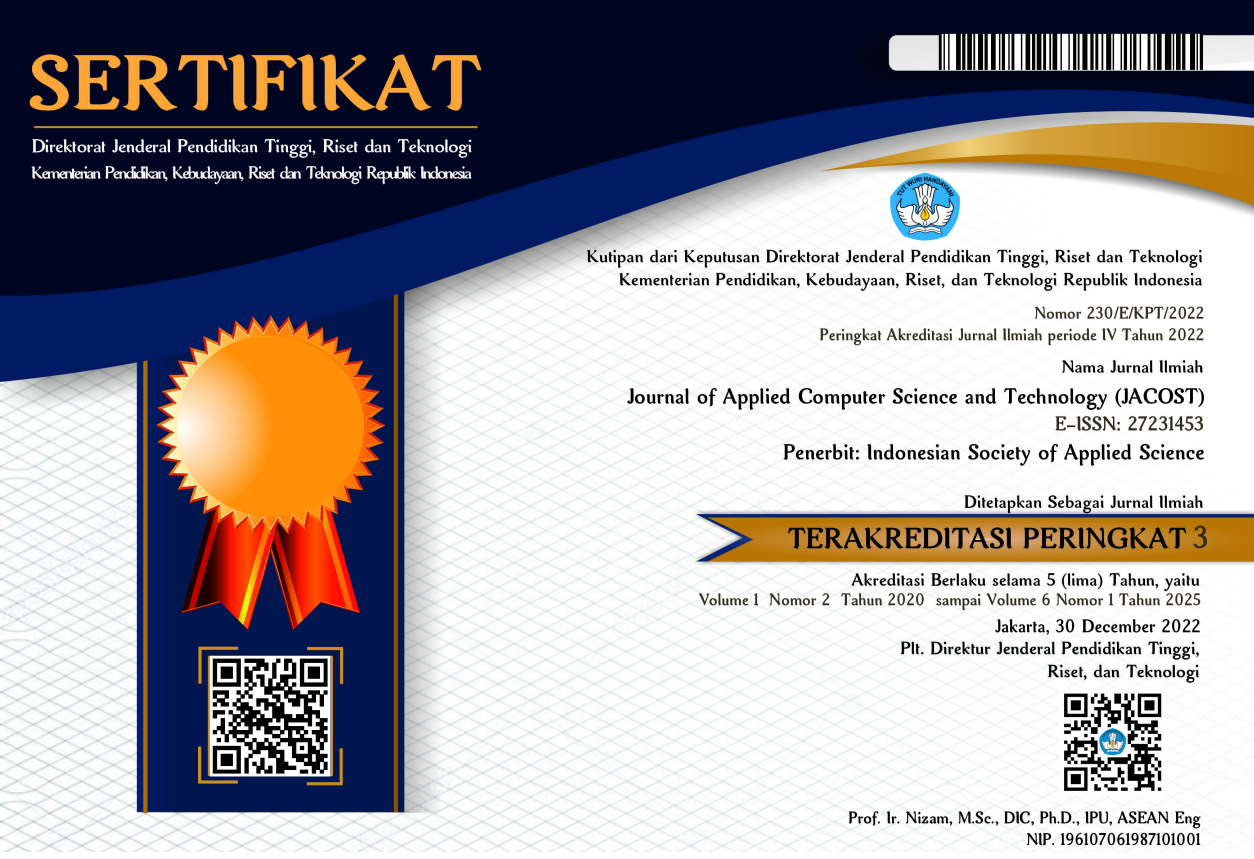Performance Comparison of Support Vector Machine (SVM) and k-Nearest Neighbors (kNN) in Verifying Material Orientation
DOI:
https://doi.org/10.52158/jacost.v6i1.1037Keywords:
Automated Optical Inspection, Inception V3, Convolutional Neural Network, Support Vector Machine, k-Nearest NeighborsAbstract
In automated manufacturing, verifying material orientation is essential to ensure the product assembly proceeds without errors. For instance, in the beverage industry, incorrect orientation of materials, such as bottle caps, can lead to failures in the packaging process, resulting in improperly sealed bottles that may compromise product quality and safety. This study compares the performance of Support Vector Machine (SVM) and k-Nearest Neighbors algorithms for verifying material orientation verification through automated optical inspection. The images were processed using the Inception V3 Convolutional Neural Network (CNN) to extract relevant image features, which were then classified using SVM and kNN algorithms. As a result, SVM achieved high classification performance during testing, with classification accuracy, precision, recall, and F1 score of 1.0 compared to kNN, which achieved only 0.967. However, kNN demonstrated superior computational efficiency, with a training time of 1.126 seconds and a validation time of 0.713 seconds, compared to SVM's training time of 3.101 seconds and validation time of 1.479 seconds. These results indicate that while both methods are highly effective for material orientation verification, kNN offers significant advantages in terms of computational speed, making it more suitable for real-time applications. The implications of this study highlight the potential for integrating the proposed method in industrial applications, promoting enhanced efficiency and reducing error rates in automated assembly lines.
Downloads
References
S. Azhar and S. I. A. Shah, "Modeling and Analysis of a Vibratory Bowl Feeder," in 2021 Seventh International Conference on Aerospace Science and Engineering (ICASE), Dec. 2021, pp. 1–13. doi: 10.1109/ICASE54940.2021.9904038.
S. Haque et al., "Automatic Product Sorting and Packaging System," in 2023 15th International Conference on Intelligent Human-Machine Systems and Cybernetics (IHMSC), Aug. 2023, pp. 163–167. doi: 10.1109/IHMSC58761.2023.00046.
R. Wulandari, M. R. Ariwibowo, T. Taryo, and G. Ananda, “Design Smart Trash Based on the Inductive Proximity Sensor,” International Journal of Multidisciplinary Approach Research and Science, vol. 2, no. 01, Art. no. 01, 2024, doi: 10.59653/ijmars.v2i01.394.
A. D. Sevtian, F. A. Kurniawan, Yulfitra, and M. Arifin, “Pemograman Sistem pada Mesin Filling Bottle PLC dengan Menggunakan Penggerak Pneumatik dan Intelegensi Sensor,” Jurnal MESIL (Mesin Elektro Sipil), vol. 3, no. 2, Art. no. 2, Dec. 2022, doi: 10.53695/jm.v3i2.807.
C. Singh, "Machine Learning in Pattern Recognition," European Journal of Engineering and Technology Research, vol. 8, no. 2, Art. no. 2, Apr. 2023, doi: 10.24018/ejeng.2023.8.2.3025.
L. Almawas, A. Alotaibi, and H. Kurdi, "Comparative Performance Study of Classification Models for Image-splicing Detection," Procedia Computer Science, vol. 175, pp. 278–285, Jan. 2020, doi: 10.1016/j.procs.2020.07.041.
A. Rajput and A. K. Singh, "Handwritten Digit Recognition Accuracy Comparison Using KNN, CNN and SVM," Educational Administration: Theory and Practice, vol. 30, no. 2, Art. no. 2, Apr. 2024, doi: 10.53555/kuey.v30i2.1676.
K. B. Narayanan, D. K. Sai, K. A. Chowdary, and S. R. K, "Applied Deep Learning Approaches on Canker Effected Leaves to Enhance the Detection of the Disease Using Image Embedding and Machine Learning Techniques," EAI Endorsed Transactions on Internet of Things, vol. 10, Mar. 2024, doi: 10.4108/eetiot.5346.
U. Ungkawa and G. A. Hakim, “Klasifikasi Warna pada Kematangan Buah Kopi Kuning menggunakan Metode CNN Inception V3,” ELKOMIKA: Jurnal Teknik Energi Elektrik, Teknik Telekomunikasi, & Teknik Elektronika, vol. 11, no. 3, Art. no. 3, Jul. 2023, doi: 10.26760/elkomika.v11i3.731.
S. Ulum, R. F. Alifa, P. Rizkika, and C. Rozikin, “Perbandingan Performa Algoritma KNN dan SVM dalam Klasifikasi Kelayakan Air Minum,” Generation Journal, vol. 7, no. 2, Art. no. 2, Jul. 2023, doi: 10.29407/gj.v7i2.20270.
R. H. Dananjaya, S. Sutrisno, and F. A. Wellianto, “Akurasi Penggunaan Metode Support Vector Machine dalam Prediksi Penurunan Pondasi Tiang,” Matriks Teknik Sipil, vol. 10, no. 3, Art. no. 3, Dec. 2022, doi: 10.20961/mateksi.v10i3.64519.
A. Singh, M. Singh, and K. Kumar, "A Hybrid Method for Intrusion Detection Using SVM and k-NN," in Conference Proceedings of ICDLAIR2019, M. Tripathi and S. Upadhyaya, Eds., Cham: Springer International Publishing, 2021, pp. 119–126. doi: 10.1007/978-3-030-67187-7_13.
D. Alita, Y. Fernando, and H. Sulistiani, “Implementasi Algoritma Multiclass SVM Pada Opini Publik Berbahasa Indonesia di Twitter,” Jurnal Tekno Kompak, vol. 14, no. 2, Art. no. 2, Aug. 2020, doi: 10.33365/jtk.v14i2.792.
Downloads
Published
Issue
Section
License
Pernyataan Hak Cipta dan Lisensi
Dengan mengirimkan manuskrip ke Journal of Applied Computer Science and Technology (JACOST), penulis setuju dengan kebijakan ini. Tidak diperlukan persetujuan dokumen khusus.
- Hak cipta pada setiap artikel adalah milik penulis.
- Penulis mempertahankan semua hak mereka atas karya yang diterbitkan, tak terbatas pada hak-hak yang diatur dalam laman ini.
- Penulis mengakui bahwa Journal of Applied Computer Science and Technology (JACOST) sebagai yang pertama kali mempublikasikan dengan lisensi Creative Commons Atribusi 4.0 Internasional (CC BY-SA).
- Penulis dapat memasukan tulisan secara terpisah, mengatur distribusi non-ekskulif dari naskah yang telah terbit di jurnal ini kedalam versi yang lain (misal: dikirim ke respository institusi penulis, publikasi kedalam buku, dll), dengan mengakui bahwa naskah telah terbit pertama kali pada Journal of Applied Computer Science and Technology (JACOST);
- Penulis menjamin bahwa artikel asli, ditulis oleh penulis yang disebutkan, belum pernah dipublikasikan sebelumnya, tidak mengandung pernyataan yang melanggar hukum, tidak melanggar hak orang lain, tunduk pada hak cipta yang secara eksklusif dipegang oleh penulis.
- Jika artikel dipersiapkan bersama oleh lebih dari satu penulis, setiap penulis yang mengirimkan naskah menjamin bahwa dia telah diberi wewenang oleh semua penulis bersama untuk menyetujui hak cipta dan pemberitahuan lisensi (perjanjian) atas nama mereka, dan setuju untuk memberi tahu rekan penulis persyaratan kebijakan ini. Journal of Applied Computer Science and Technology (JACOST) tidak akan dimintai pertanggungjawaban atas apa pun yang mungkin timbul karena perselisihan internal penulis.
Lisensi :
Journal of Applied Computer Science and Technology (JACOST) diterbitkan berdasarkan ketentuan Lisensi Creative Commons Atribusi 4.0 Internasional (CC BY-SA). Lisensi ini mengizinkan setiap orang untuk :.
- Berbagi — menyalin dan menyebarluaskan kembali materi ini dalam bentuk atau format apapun;
- Adaptasi — menggubah, mengubah, dan membuat turunan dari materi ini untuk kepentingan apapun.
Lisensi :
-
Atribusi — Anda harus mencantumkan nama yang sesuai, mencantumkan tautan terhadap lisensi, dan menyatakan bahwa telah ada perubahan yang dilakukan. Anda dapat melakukan hal ini dengan cara yang sesuai, namun tidak mengisyaratkan bahwa pemberi lisensi mendukung Anda atau penggunaan Anda.
-
BerbagiSerupa — Apabila Anda menggubah, mengubah, atau membuat turunan dari materi ini, Anda harus menyebarluaskan kontribusi Anda di bawah lisensi yang sama dengan materi asli.

















